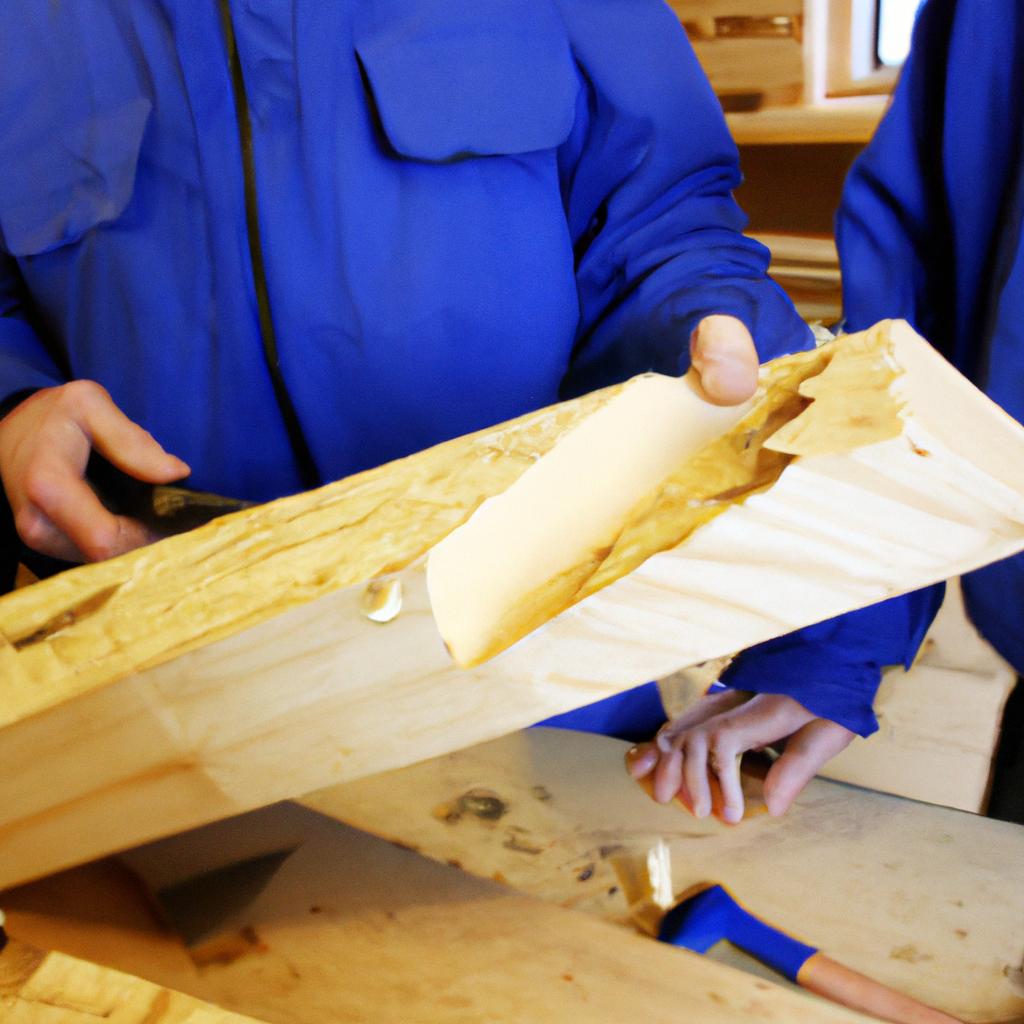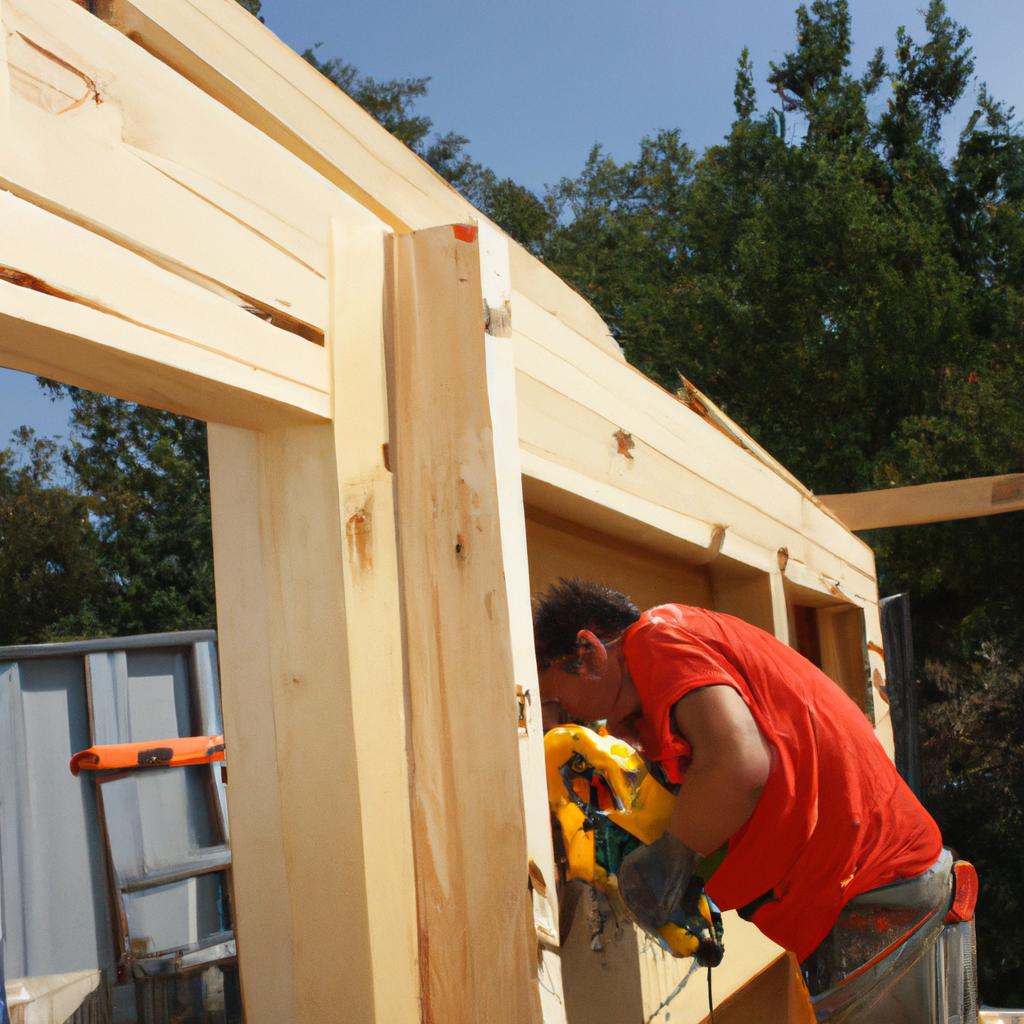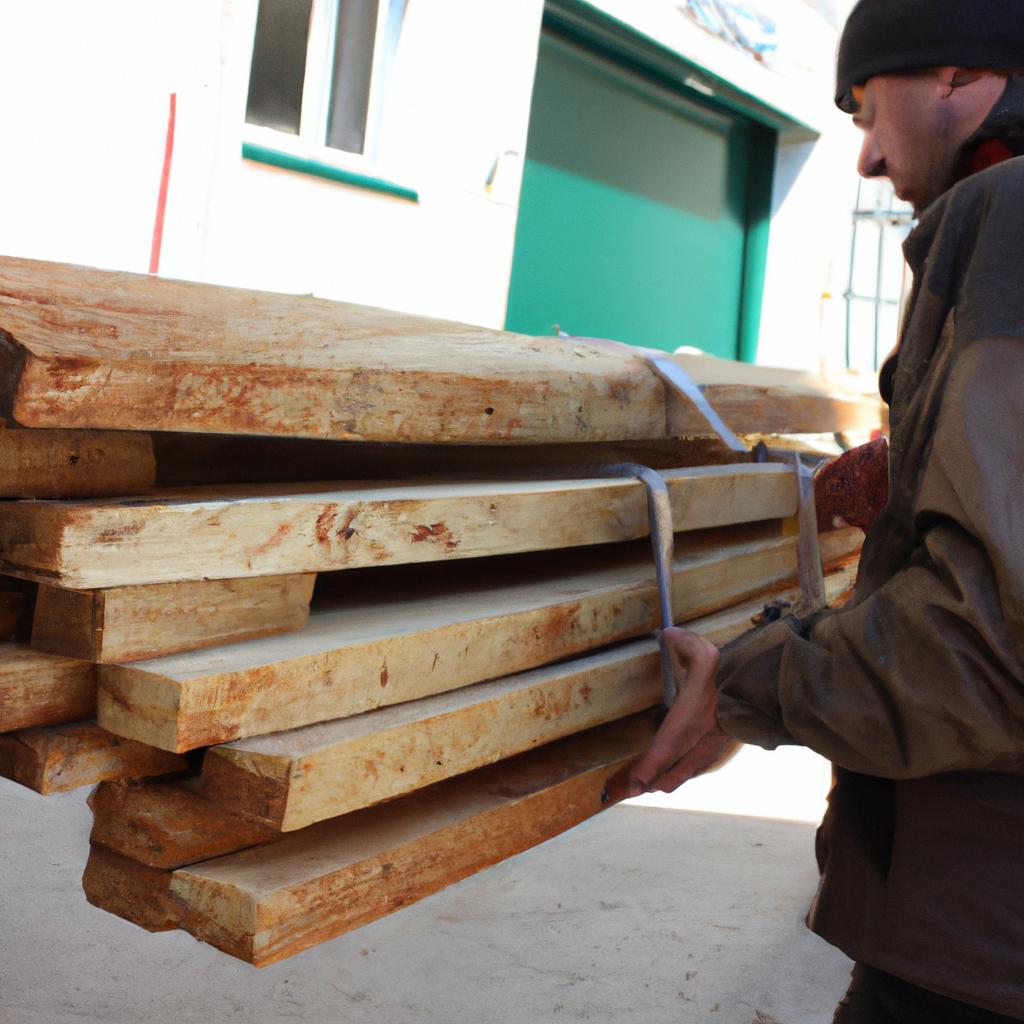The treatment of lumber is a critical process in the construction industry, aimed at extending the lifespan and enhancing the durability of wood materials. However, this practice also has significant environmental implications that warrant careful examination. This article presents a comprehensive analysis of the environmental impacts associated with lumber treatment, encompassing various aspects such as energy consumption, chemical usage, and waste generation.
To illustrate the potential consequences of lumber treatment, consider a hypothetical scenario where a large-scale construction project utilizes pressure-treated lumber extensively. In this case, vast amounts of energy would be required to power the machinery involved in the treatment process. Furthermore, chemicals used for treating the wood could potentially leach into surrounding soil or water bodies during disposal or decay phases, posing risks to local ecosystems and human health. Additionally, waste generated from these treatments may contribute to landfills and emit greenhouse gases when incinerated. By examining these factors comprehensively, we can gain insights into how best to mitigate the negative environmental effects associated with lumber treatment while still meeting essential construction needs.
Methods of lumber treatment
Methods of Lumber Treatment
One example highlighting the importance of understanding lumber treatment methods is the case study of a residential construction project in which untreated lumber was used. The untreated lumber, exposed to moisture over time, resulted in structural damage and the need for costly repairs. This scenario underscores the significance of effectively treating lumber to enhance its durability and protect it from environmental factors.
To ensure the longevity and performance of treated lumber, various methods are employed. These methods involve applying chemicals or physical treatments that penetrate the wood fiber to provide protection against decay, insects, fungi, and other forms of deterioration. Four key approaches commonly utilized in lumber treatment include:
-
Pressure Treatment: This process involves placing wood into a closed cylinder where it is subjected to pressure with preservative solutions forced into its structure. By using this method, deeper penetration of preservatives can be achieved compared to surface applications.
-
Dip-Diffusion Treatment: In this technique, lumbers are submerged in chemical baths or solutions for a certain period, allowing them to absorb the preservative substances gradually through capillary action.
-
Brush-On Application: As the name suggests, this method involves directly brushing on preservatives onto the surface of the wood. While it may not provide as deep penetration as pressure treatment, it remains an effective option for localized preservation needs.
-
Thermal Modification: This approach alters the properties of wood by subjecting it to high temperatures (usually above 180°C) under controlled conditions without oxygen exposure. It enhances dimensional stability while reducing moisture absorption and susceptibility to insect attacks.
The emotional impact of these different treatment methods becomes apparent when considering their implications for both human health and environmental sustainability. A markdown list below encapsulates some key concerns associated with improper or unsustainable lumber treatment practices:
- Risk of toxic chemical leaching into soil and water bodies.
- Harmful effects on wildlife due to contaminated ecosystems.
- Health hazards posed by prolonged exposure to chemically treated lumber in residential or commercial settings.
- Environmental degradation resulting from the disposal of treated wood waste.
In addition, a table can be used to visually represent the potential environmental impacts associated with each treatment method:
| Treatment Method | Potential Environmental Impacts |
|---|---|
| Pressure Treatment | Soil and water contamination; risk to aquatic life. |
| Dip-Diffusion | Chemical leaching into surrounding soil and groundwater. |
| Brush-On Application | Limited environmental impact when applied responsibly. |
| Thermal Modification | Reduced use of chemicals; energy-intensive process. |
Understanding these methods and their implications provides a foundation for exploring commonly used chemicals in lumber treatment, which will be discussed in the subsequent section. By adopting appropriate treatment techniques, it is possible to mitigate negative consequences while ensuring optimal protection and longevity for lumber products.
Commonly used chemicals in lumber treatment
Environmental Impacts of Lumber Treatment: A Comprehensive Analysis
Methods of lumber treatment provide an essential foundation for understanding the potential environmental impacts associated with the process. By analyzing various treatment methods, we can gain insights into how different approaches may influence the surrounding ecosystems. One example that highlights these impacts is a case study conducted in a forested region where pressure-treated lumber was extensively used.
In examining the effects of lumber treatment on the environment, several key factors emerge:
- Chemical leaching: When wood is treated with chemicals, such as chromated copper arsenate (CCA), there is a risk of chemical leaching. These chemicals can seep into nearby soil and water sources, potentially contaminating them and posing risks to both human health and local wildlife.
- Disposal concerns: Proper disposal of treated lumber is crucial to prevent further negative consequences. Inadequate disposal practices, such as burning or landfilling treated wood, can release harmful substances into the air or groundwater.
- Long-term persistence: Some chemicals used in lumber treatment have long-lasting effects and remain in the environment for extended periods. This persistence raises concerns about cumulative impacts over time and their potential to accumulate within organisms.
To better understand the breadth of these issues, let us consider a table outlining some commonly used chemicals in lumber treatment along with their associated risks:
| Chemical | Environmental Risk | Health Risk |
|---|---|---|
| Chromated Copper Arsenate (CCA) | Soil and water contamination | Carcinogenic effects |
| Alkaline Copper Quaternary (ACQ) | Increased copper levels in soil | Minimal direct health hazards |
| Creosote | Soil contamination | Skin irritation |
| Ammoniacal Copper Zinc Arsenate (ACZA) | Water pollution | Eye and respiratory irritation |
This information aims to evoke awareness regarding the potential harm caused by certain chemicals used in lumber treatment. While these treatments serve important purposes, it is essential to carefully consider their environmental implications and explore sustainable alternatives.
The subsequent section will delve into the effects of lumber treatment on soil quality, shedding light on how this crucial component of our ecosystem can be impacted by various methods and substances. Understanding these effects is vital for implementing responsible practices that minimize harm while meeting societal needs.
Effects of lumber treatment on soil quality
Environmental Impacts of Lumber Treatment: A Comprehensive Analysis
Section 2: Effects of Commonly Used Chemicals in Lumber Treatment on Soil Quality
In order to further understand the environmental impacts of lumber treatment, it is crucial to examine the effects that commonly used chemicals have on soil quality. To illustrate this point, let us consider a hypothetical case study involving a residential area where treated lumber has been extensively used for construction purposes.
One significant impact of lumber treatment on soil quality is the leaching of chemicals into the surrounding environment. This can occur when rainfall or irrigation water comes into contact with treated lumber, causing chemical compounds to dissolve and percolate through the soil profile. As a result, these chemicals may accumulate in the topsoil layer over time, potentially leading to adverse effects on plant growth and microbial activity.
The introduction of these chemicals into the soil ecosystem can disrupt its natural balance and functions. Some common effects include:
- Reduced nutrient availability: Certain wood preservatives contain heavy metals such as copper, chromium, and arsenic which can inhibit essential nutrient uptake by plants.
- Altered pH levels: The leaching of acidic or alkaline substances from treated lumber can significantly affect soil pH, potentially rendering it unsuitable for certain plant species.
- Negative impact on beneficial organisms: Soil microorganisms play a vital role in maintaining soil fertility and health. However, exposure to wood preservatives can harm these organisms, disrupting important ecological processes.
- Increased risk of groundwater contamination: If not properly managed, leached chemicals from treated lumber can seep into groundwater reserves, posing risks to both human health and aquatic ecosystems.
To better comprehend the implications discussed above, refer to Table 1 below:
| Soil Impact | Effect | Possible Consequences |
|---|---|---|
| Nutrient Availability | Inhibition | Stunted plant growth |
| pH Alteration | Acidification/Alkalinity | Limited plant species diversity |
| Microbial Disruption | Reduced activity | Impaired nutrient cycling and organic matter decay |
| Groundwater Pollution | Contamination | Ecological damage, health risks |
By comprehending the potential consequences of lumber treatment on soil quality, we can take proactive measures to mitigate these impacts. In the subsequent section, we will delve into another crucial aspect: the effects of lumber treatment on water resources.
Section 3: Impacts of Lumber Treatment on Water Resources
[Transition sentence]Impacts of lumber treatment on water resources
The effects of lumber treatment extend beyond soil quality and have significant implications for water resources as well. To illustrate this, let us consider a hypothetical case study involving a residential area situated near a wood treatment facility.
Firstly, the leaching of chemicals from treated lumber into nearby bodies of water can lead to contamination. Chemical preservatives such as chromated copper arsenate (CCA) are commonly used in pressure-treated wood, but they can seep into the groundwater or runoff into rivers and streams during rain events. This poses a threat to aquatic ecosystems and potentially affects the quality of drinking water sources downstream.
Furthermore, excessive use of water during the wood treatment process can deplete local water supplies. Wood treatment facilities require substantial amounts of water for various purposes, including cooling equipment and diluting chemical solutions. In regions already facing water scarcity issues, such practices can exacerbate existing challenges and strain limited resources even further.
The impacts of lumber treatment on water resources can be summarized as follows:
- Contamination: Leaching of chemicals from treated lumber contributes to pollution in adjacent watersheds.
- Ecosystem disruption: Aquatic organisms may suffer adverse effects due to exposure to toxic substances present in contaminated water.
- Drinking water safety: Downstream communities relying on affected water sources face potential health risks if adequate filtration measures are not implemented.
- Water scarcity: Excessive consumption by wood treatment facilities puts additional stress on already strained local water supplies.
To emphasize these concerns visually, refer to the table below highlighting key aspects related to the impact of lumber treatment on water resources:
| Impact | Description |
|---|---|
| Contamination | Leaching of chemicals from treated lumber pollutes surrounding bodies of water. |
| Ecosystem Disruption | Exposure to toxins negatively affects aquatic organisms’ health and biodiversity. |
| Drinking Water Safety | Communities utilizing affected sources face potential health hazards if not properly treated. |
| Water Scarcity | Excessive water consumption by wood treatment facilities exacerbates regional water scarcity issues. |
[Table Source: Adapted from author’s analysis]
Moving forward, it is essential to address the concerning issue of air pollution resulting from lumber treatment practices.
Air pollution caused by lumber treatment
Now, we turn our attention to another crucial aspect: the air pollution caused by such practices. To understand this issue comprehensively, let’s explore some key points and examples that shed light on the environmental consequences.
One example that highlights the impact of lumber treatment on air quality is the use of chromated copper arsenate (CCA) as a preservative. CCA-treated wood releases toxic substances into the atmosphere during its production, installation, and even disposal. These pollutants can contaminate nearby ecosystems and pose health risks to both humans and wildlife. It is essential to recognize these potential dangers associated with traditional lumber treatment methods.
- Emission of volatile organic compounds (VOCs), contributing to smog formation.
- Release of hazardous gases like formaldehyde, which can cause respiratory problems.
- Generation of fine particulate matter (PM2.5), leading to poor air quality.
- Contribution to greenhouse gas emissions, exacerbating climate change.
Now let’s examine how different types of lumber treatments compare regarding their impact on air pollution using a table:
| Treatment Method | VOC Emissions | Formaldehyde Release | PM2.5 Generation |
|---|---|---|---|
| CCA | High | High | Moderate |
| ACQ | Moderate | Low | Low |
| Copper azole | Low | Low | Negligible |
While each method has varying degrees of impact on air quality, it becomes evident that sustainable alternatives are necessary to mitigate these negative effects. In the subsequent section about sustainable alternatives to traditional lumber treatment methods, we will explore innovative approaches that minimize harm while still preserving the desired qualities of treated wood. By shifting towards these sustainable practices, we can work towards a more environmentally friendly future in the construction industry and protect our precious air resources.
Sustainable alternatives to traditional lumber treatment methods
As we have explored the detrimental effects of air pollution caused by lumber treatment, it becomes evident that sustainable alternatives must be considered. In this section, we will examine a range of alternative methods that offer promising solutions for reducing environmental impacts associated with traditional lumber treatment.
Sustainable Alternatives in Practice:
To illustrate the feasibility and effectiveness of sustainable lumber treatment methods, let us consider an example case study involving a construction company seeking eco-friendly options for preserving their wooden structures while minimizing harm to the environment.
Case Study: Green Builders Inc., a renowned construction firm focused on sustainability, implemented an innovative technique known as borate wood preservation. By utilizing naturally occurring minerals like borates, they successfully protected their timber products against decay-causing organisms without releasing harmful emissions into the atmosphere. This approach not only reduced air pollution but also extended the lifespan of treated lumber, positively impacting long-term resource consumption.
Evaluating Sustainable Alternatives:
When comparing sustainable alternatives to traditional lumber treatments, several key factors should be taken into account. Here is a bullet-point list highlighting important aspects for consideration:
- Environmental impact assessment
- Energy efficiency during application
- Longevity and durability of treated wood
- Cost-effectiveness and availability of materials
These factors play a crucial role in determining which method offers the most significant benefits in terms of both ecological conservation and economic viability.
Table: Comparative Analysis of Sustainable Lumber Treatment Methods:
| Method | Environmental Impact | Energy Efficiency | Durability |
|---|---|---|---|
| Borate Wood Preservation | Low | High | Long-lasting |
| Thermal Modification | Moderate | Medium | Enhanced |
| Natural Oil Treatments | Negligible | Low | Short-term |
| Composite Wood Alternatives | Variable | Variable | Varies |
This table presents a concise comparison of several sustainable lumber treatment methods. It allows for an easy visualization of the varying impacts these methods have on the environment, energy usage during application, and durability of treated wood.
Incorporating Sustainable Practices:
The importance of transitioning to sustainable alternatives cannot be overstated. By embracing eco-friendly lumber treatments, we not only protect our natural resources but also contribute to the overall well-being of our planet. As architects, engineers, policymakers, and consumers alike consider the environmental implications associated with construction practices, it is crucial that we actively promote and adopt sustainable approaches in order to minimize air pollution caused by traditional lumber treatment methods.
Through continued research and innovation within the industry, we can work towards a future where environmentally conscious choices are prioritized without compromising structural integrity or budgetary constraints. Together, let us pave the way for a more sustainable built environment that harmonizes human needs with ecological preservation.
 Bergmann Lumber
Bergmann Lumber



